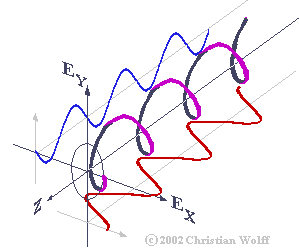I quote from my textbook, " Consider two vertical slits S1 and S2 placed parallel to each other, and a string is passed through them. The end B is fixed and A is given jerks perpendicular to its length. If on rotating slit S2 till it is perpendicular to S1 the amplitude of vibrations becomes zero then the wave is a transverse wave, otherwise it is a longitudinal wave."
I understand how this works for mechanical transverse waves, but not for light. The electric and magnetic vectors do not have spatial extension, though it is shown that way in animations. The oscillating vectors just show the varying magnitude of the fields at points on the ray of light. Otherwise its like saying a physical arrow(velocity vector) extends in front of a moving body whose size depends on the body"s velocity.
So my question is why should the amplitude of light be affected when the oscillations have no spatial extension(considering just one ray of light passing through the slits)?


Best Answer
You are right that the oscillations of the electromagnetic field need not have any spatial extent. The oscillations, as you point out, are in the strength of the electric and magnetic fields. If I understand your question correctly, you are asking why then can some objects distinguish between the two different polarizations of light.
This is because anisotropic materials (those which do not have exactly the same structure in all directions) can act differently to electric fields which lie along their different axes. In the image below the material in the middle does not support an electric field in the horizontal direction. When you try to establish an electric field in the horizontal direction, energy is taken out of the source which is trying to establish it (the light in this case). So, this material, which acts as a typical polarizer, only allows light which is polarized in the vertical direction to pass.
There are other ways to distinguish between the two different polarizations of light. Birefringent crystals, for instance, have a different index of refraction for the two different polarizations of light. They therefore deflect the two different polarizations of light by a different amount.